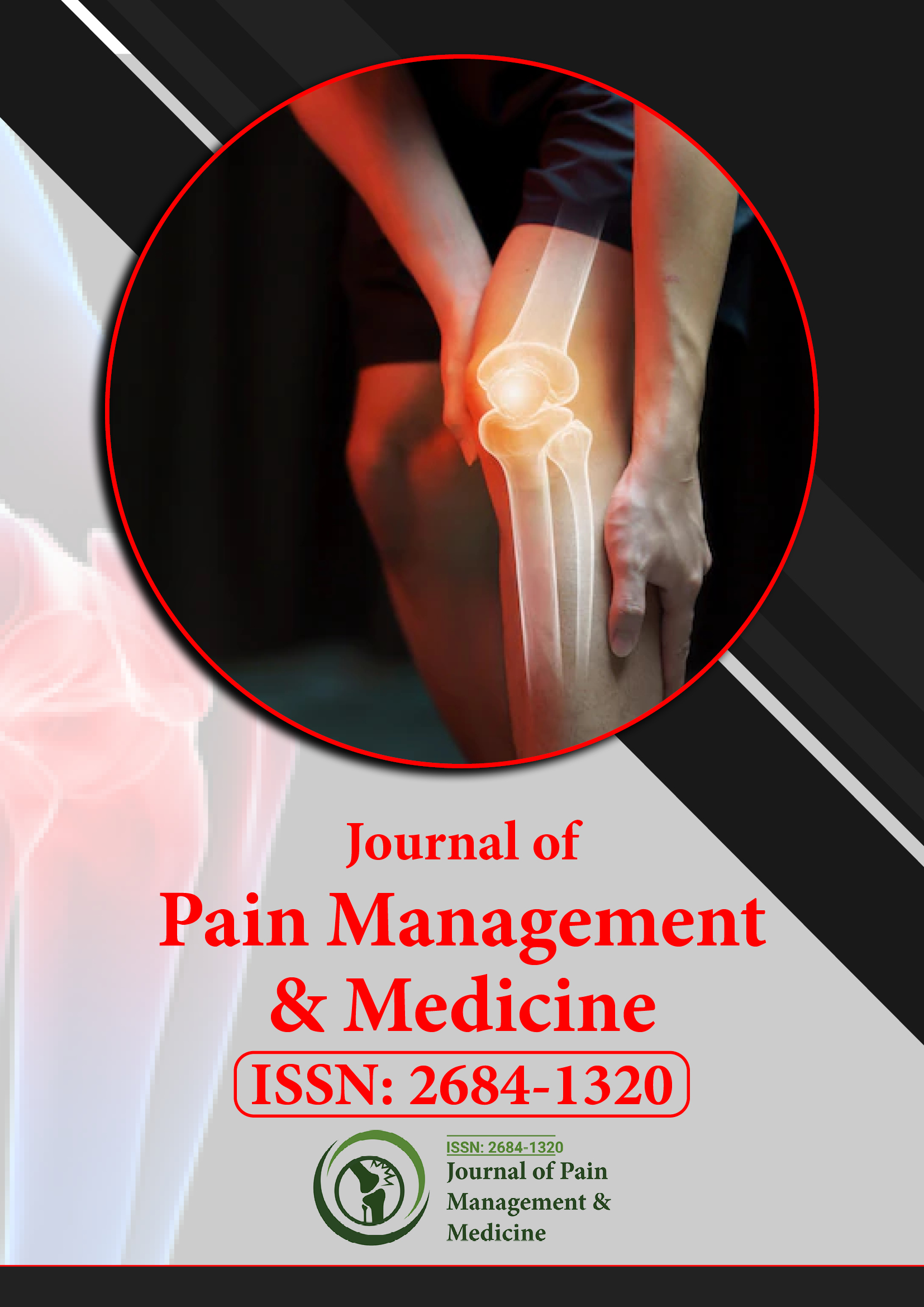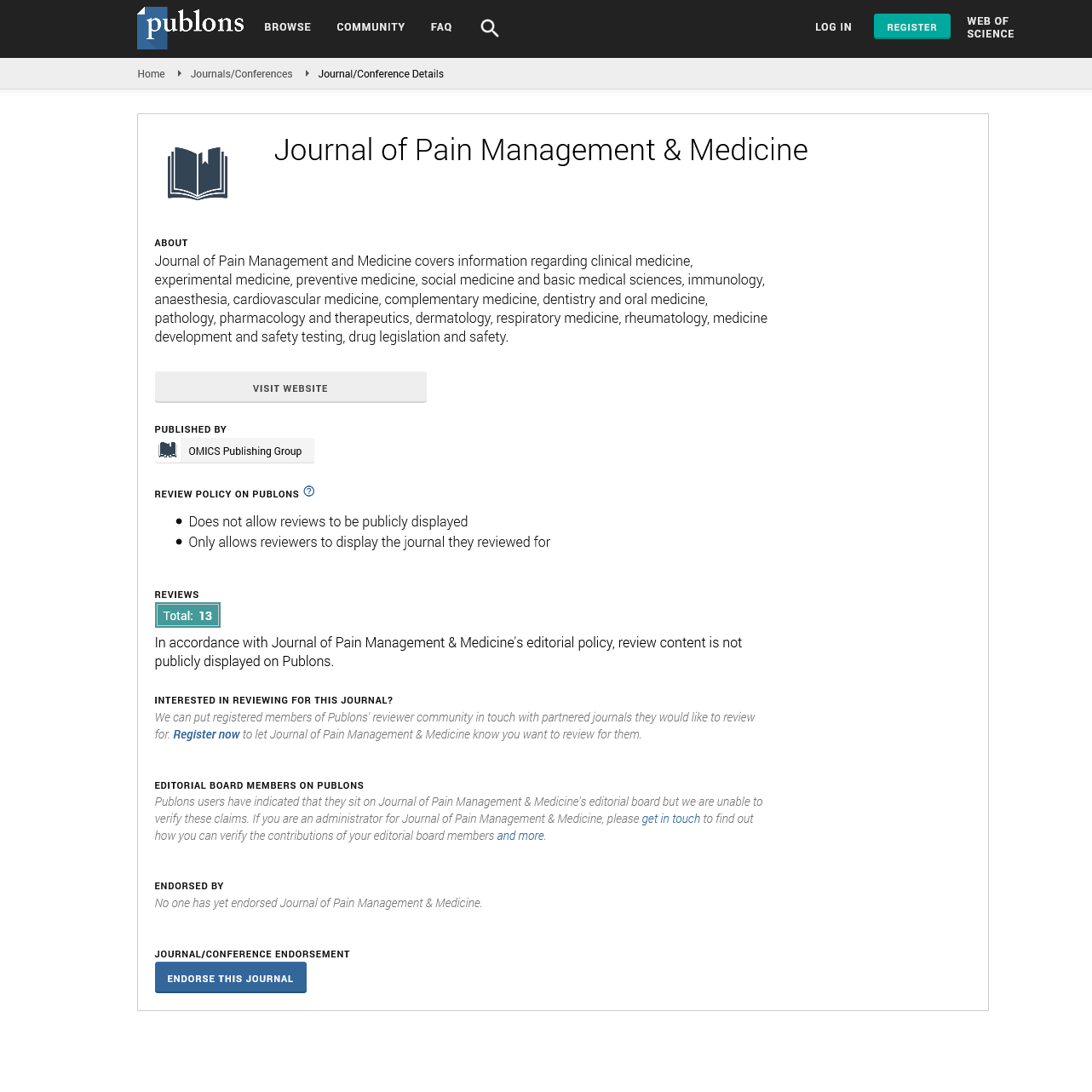Indexed In
- RefSeek
- Hamdard University
- EBSCO A-Z
- Publons
- Euro Pub
- Google Scholar
- Quality Open Access Market
Useful Links
Share This Page
Journal Flyer

Open Access Journals
- Agri and Aquaculture
- Biochemistry
- Bioinformatics & Systems Biology
- Business & Management
- Chemistry
- Clinical Sciences
- Engineering
- Food & Nutrition
- General Science
- Genetics & Molecular Biology
- Immunology & Microbiology
- Medical Sciences
- Neuroscience & Psychology
- Nursing & Health Care
- Pharmaceutical Sciences
Perspective - (2025) Volume 11, Issue 2
Role of Neuroinflammation in the Transition from Acute to Chronic Post-Surgical Pain: A Longitudinal Cohort Study
Erica Nindberg*Received: 01-Mar-2025, Manuscript No. JPMME-25-28858 ; Editor assigned: 03-Mar-2025, Pre QC No. JPMME-25-28858 (PQ); Reviewed: 17-Mar-2025, QC No. JPMME-25-28858 ; Revised: 24-Mar-2025, Manuscript No. JPMME-25-28858 (R); Published: 31-Mar-2025, DOI: 10.35248/2684-1320.25.11.324
Description
The persistence of pain long after surgical tissue healing, termed Chronic Post-Surgical Pain (CPSP), represents a significant clinical challenge with substantial impact on patient quality of life and healthcare resources. While various factors have been implicated in its development, the role of neuroinflammation – inflammatory processes within the peripheral and central nervous systems – is increasingly recognized as a critical contributor to the transition from acute to chronic pain. A well-designed longitudinal cohort study meticulously investigating the temporal dynamics of neuroinflammatory markers in patients undergoing surgery offers invaluable perspectives on this complex phenomenon and could pave the way for novel preventative and therapeutic strategies.
Such a study would ideally enroll a cohort of patients undergoing a specific type of surgery known to have a significant incidence of CPSP. Serial assessments of pain intensity and functional limitations would be conducted preoperatively and at multiple time points postoperatively, spanning the acute (days to weeks) and subacute/chronic (months) phases. Crucially, the study would incorporate the longitudinal measurement of key neuroinflammatory biomarkers in biological samples such as Cerebrospinal Fluid (CSF) – if ethically feasible and clinically indicated for a subset – or peripheral blood. These biomarkers could include pro-inflammatory cytokines (e.g., IL-1β, IL-6, TNF-α), chemokines (e.g., MCP-1, CXCL8), glial activation markers (e.g., S100B, GFAP), and potentially even neuroimaging techniques in a subset to visualize changes in brain activity and neuroinflammation.
One critical perspective this study would illuminate is the temporal relationship between the trajectory of acute postoperative pain and the evolution of neuroinflammatory markers. By tracking both pain levels and biomarker concentrations over time, researchers could identify whether a prolonged or heightened acute inflammatory response correlates with elevated and persistent neuroinflammation, ultimately predicting the development of CPSP. Understanding this temporal cascade is crucial for identifying potential therapeutic windows for intervention.
Another vital perspective concerns the specific neuroinflammatory mediators that are most strongly associated with the transition to chronicity. Identifying a distinct signature of cytokines, chemokines, or glial activation markers that differentiate patients who develop CPSP from those who recover uneventfully would provide valuable targets for future drug development. For instance, if elevated levels of a particular chemokine during the acute postoperative phase are strongly predictive of chronic pain, then interventions aimed at blocking that chemokine's activity could be explored as a preventative strategy.
The study could also shed light on the role of peripheral versus central neuroinflammation in the development of CPSP. While peripheral inflammation at the surgical site is an expected initial response, the study could investigate whether this peripheral inflammation "primes" or triggers inflammatory processes within the spinal cord and brain. Comparing biomarker levels in peripheral blood and CSF (if available) at different time points could provide insights into the communication pathways between the peripheral and central nervous systems in the context of post-surgical pain.
From a patient-centered perspective, the study could explore whether individual differences in baseline inflammatory status, genetic predispositions to inflammation, or the presence of pre-existing comorbidities (e.g., autoimmune conditions, chronic inflammatory diseases) influence the postoperative neuroinflammatory response and the risk of developing CPSP. Identifying these patient-specific risk factors could allow for more personalized preventative strategies.
The study might also investigate the impact of different surgical techniques and perioperative pain management strategies on the neuroinflammatory response. For example, comparing minimally invasive surgery with more invasive procedures, or assessing the effects of different analgesic regimens (e.g., opioids vs. regional anesthesia) on neuroinflammatory markers could reveal modifiable factors that influence the likelihood of developing CPSP. This information would have direct implications for optimizing surgical and anesthetic practices.
Furthermore, the longitudinal nature of the study would allow for the examination of the resolution of neuroinflammation in patients who do not develop CPSP. Understanding the mechanisms that promote the downregulation of inflammatory processes and the restoration of homeostasis in these individuals could provide valuable clues for promoting similar resolution in those at risk of or experiencing chronic pain.
Finally, from a translational perspective, the identification of key neuroinflammatory mediators and their temporal profiles could lead to the development of novel diagnostic tools to predict the risk of CPSP early in the postoperative period. This would allow for targeted interventions – pharmacological or non-pharmacological – aimed at dampening neuroinflammation and preventing the establishment of chronic pain.
In conclusion, a longitudinal cohort study meticulously investigating the role of neuroinflammation in the transition from acute to chronic post-surgical pain holds immense potential to transform our understanding of this debilitating condition. By characterizing the temporal dynamics of key neuroinflammatory markers and their association with pain trajectories, such research can pave the way for the development of targeted preventative and therapeutic strategies aimed at mitigating the burden of CPSP and improving the lives of millions of surgical patients.
Citation: Lindberg E (2025) Mindfulness-Based Interventions Versus Traditional Cognitive Behavioral Therapy for Chronic Low Back Pain. J Pain Manage Med. 11.324.
Copyright: © 2025 Lindberg E. This is an open access article distributed under the terms of the Creative Commons Attribution License, which permits unrestricted use, distribution, and reproduction in any medium, provided the original author and source are credited.

